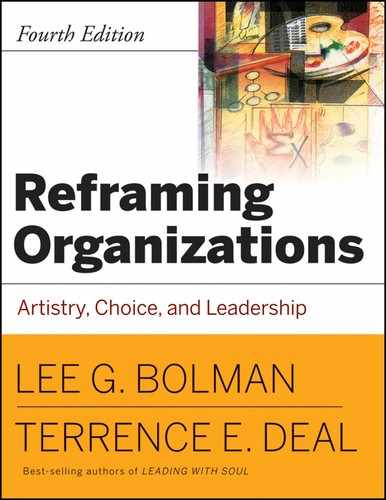Up to now, we have emphasized the unique features of four distinctive ways to think about organizations. But making sense of a complex situation is not a single-frame activity. A messy, turbulent world rarely presents bounded, well-defined problems. In this part of the book, we focus on combining lenses to achieve multi-frame approaches to managing and leading.
In Chapter Fifteen, we contrast a stereotype of crisp, orderly rationality with a more frantic, reactive reality of managerial life. We show how routine activities and processes such as strategic planning, decision making, and conflict take on different meanings depending on how they are viewed. We provide an example to illustrate the cacophony that arises when parties are seeing different realities. Finally, we look at studies of effective organizations and senior managers to examine how research aligns with our framework.
In Chapter Sixteen, we examine a case of a middle manager who encounters an unexpected crisis on the first day in a new job. We show how, in a situation where the stakes and risks are high, each lens spawns both helpful and unproductive scenarios for her response.
We turn in Chapter Seventeen to a discussion of leadership. We begin with an example of a prominent leader in crisis to examine the interaction between leader and circumstances. We explore the concept of leadership and review research on the characteristics of effective leaders. After dissecting some popular leadership models, we illustrate each frame's image of leaders and leadership.
Chapter Eighteen takes us to a perennial challenge: creating change. We examine predictable barriers each frame suggests and point out different remedies. We then integrate the frames with a stage model of change. The two in combination provide a powerful map.
Ethics and spirit are the focus of Chapter Nineteen. We begin with a look at what went wrong at Enron. While Enron had plenty of smart, aggressive people, it lacked wisdom and soul. We end by discussing four criteria for ethical behavior: authorship, love, justice, and significance.
Chapter Twenty presents an integrative case in which we zoom in on a new principal in his perilous early weeks at a troubled urban high school. We illustrate how the frames in tandem generate a more comprehensive diagnosis of the issues and offer more promising options for moving ahead.
Finally, in the Epilogue, we summarize the basic messages of the book and lay out implications for the development of future leaders.
